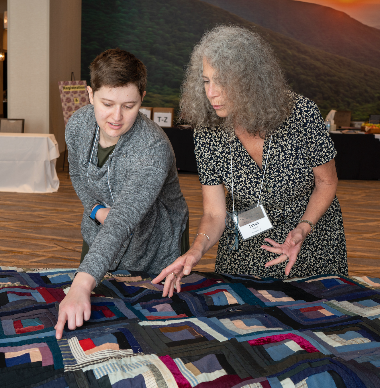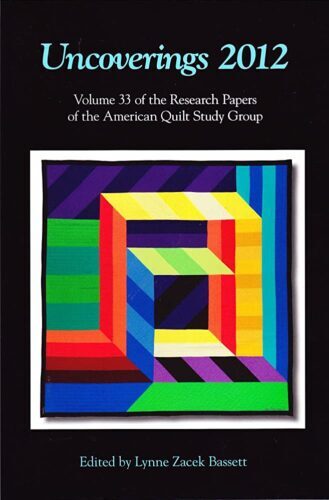Foreward
A FACEBOOK FRIEND AND I have recently been debating the term “artisan quilter;’ as used by Pottery Barn to promote its new line of designer quilts. Is every quilter an artisan? If every quilter is an artisan, does that mean every quilt has artistic merit? No matter which side of the debate you take, it must be acknowledged that the quilters presented in this volume of Uncoverings put careful thought and artistry into their quilts. Their stitches give voice to personal messages of mourning, spirituality, fear, pride, de light, anger, and determination.
Peggy Hazard provides the AQSG 2016 Seminar attendees in Tempe, Arizona, with an intimate look at the difficult and divisive issue of illegal immigration in the state. Using the discarded clothing of migrants making the dangerous desert crossing from Mexico into Arizona, The Migrant Quilt Project commemorates the lives lost under the unforgiving sun and opens a conversation not only about humanity, grief, and generosity, but about public policy. Unlike the faceless and sometimes even nameless peo ple commemorated by The Migrant Quilt Project, the makers of the funeral ribbon quilts studied by Diana Bell-Kite memorialized their own family members. Bell-Kite documents the southern practice of collecting the rib bons from funeral floral arrangements in order to stitch together a treas ured keepsake of the ceremony as well as the loved one. The demise of the practice with the floral industry’s shift to thinner, less-stable ribbon mate rial has made this a bygone tradition-important to document now, before these inherently fragile quilts disintegrate or are forgotten by families sepa rated by time or distance from the maker.
Mourning is not always due to the death of a beloved friend or family member. The loss of a dream can also cause profound sadness. Jonathan Gregory examines this sort of mourning in his essay, “Why Ernest Haight Made Quilts:’ In the face of the 1930s economic depression that took away his career hopes and caused severe stress over his family’s well-being, Ernest Haight turned his engineering skills to quilt design in order not to “crack
Foreword 5
up.” His success as a quiltmaker not only satisfied his own intellectual goals, but also his desire to be useful to his community. In contrast to Haight’s difficult situation, in that same decade of the Great Depression, wealthy socialite Mildred Potter Lissauer also set out to prove her talents as a quilt designer. Sandy Staebell offers an in-depth study of Lissauer’s colo nial revival Godey Quilt, discussing its inspiration, sources, and produc tion. Staebell presents new information about this well-known quilt-how Lissauer developed her design, and how other talented needlewomen ful filled Lissauer’s vision. Both Ernest Haight and Mildred Potter Lissauer sought praise and validation of their work-Haight, through his county and state agricultural fairs, and Lissauer through national competitions and publications.
The decades following the Great Depression were generally quiet ones in American quilt history, but there was a significant ramping-up of inter est as the country got closer to the Bicentennial of 1976. Colleen Hall Patton examines how quilts were perceived by the writers for American women’s magazines between 1940 and 1971, focusing particularly on the beginnings of feminist values associated with the practice of quilting quilting not just within the context of homemaking, but quiltmaking as a legitimate and worthy outlet for a woman’s creativity (or “artisanrY:’ to re turn to the opening debate of this Foreword), personal expression, and time. Hall-Patton ends her study just prior to the beginning of the Quilt Revival in the 1970s, as large numbers of women rediscovered this textile
art as a medium for more than just home decoration or warmth. The quilts of Mary Catherine Lamb are a dynamic result of the growth of the Quilt Revival. Susan Stanley assigns Lamb’s work-which is only now gaining a widespread appreciation for its imagination, beauty, and imagery-to its deserved place within the Studio Art Quilt movement of the 1990s and 2000s. Lamb created tributes to her Catholic upbringing that were both honorific and humorous. Constructed of unusual fabrics gathered from thrift shops and yard sales, she sliced, skewed, and arranged the pieces to create slightly off-kilter images of biblical saints and monsters.
I would argue that an important element of art is emotion-the emo tion with which it is imbued by its creator, and the emotion it evokes in the viewer. While (in my humble opinion) not all quilts rise to the level of art or even artisanry, this volume of Uncoverings offers significant fodder for consideration of the importance of quilts as art and emotional expression.
-Lynne Zacek Bassett
Lynne Zacek Bassett is an award-winning independent scholar specializing in New England’s historic costume and textiles. Among her quilt publications and exhibitions are Northern Comfort: New England’s Early Quilts, 1780-1850, produced for Old Sturbridge Village in 1998, and Telltale Textiles: Quilts from the Historic Deerfield Collection (2002). Lynne was the editor and primary author of Massachusetts Quilts: Our Common Wealth (2009 ). In 2012 appeared Homefront & Battlefield: Quilts & Context in the Civil War, co-authored by Bassett and Madelyn Shaw and published by the American Textile History Museum. Bassett holds a BA in American studies from Mount Holyoke College and a MA in costume and textile history from the University of Connecticut.



